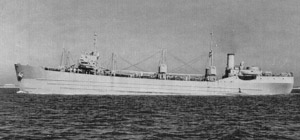The McCloskey Ships of The Second World War
Just as steel had become scarce during the First World War, the Second World War was again consuming the country's steel resources. In 1942, the United States Maritime Commission contracted McCloskey and Company of Philadelphia, Pennsylvania to build a new fleet of 24 concrete ships. Three decades of improvements in concrete technology made this new fleet lighter and stronger than its WWI predecessors.

Photo of the S.S. Arthur Talbot
The ships were constructed in Tampa, Florida starting in July of 1943. The ships were built at an incredible rate, with one being launched a month. The ships were named after pioneers in the science and development of concrete.
Two of the ships were sunk as blockships in the Allied invasion of Normandy. Nine more were sunk as breakwaters for a ferry landing at Kiptopeke, Virginia. Two are wharves in Yaquina Bay in Newport, Oregon and seven are still afloat in a giant breakwater on the Powell River in Canada.
Ships
- S.S. P. M. Anderson
- S.S. John Aspdin
- S.S. Henri Le Chateliere
- S.S. Armand Considere
- S.S. William Foster Cowham
- S.S. Edwin Clarence Eckel
- S.S. John Grant
- S.S. Francois Hennebique
- S.S. Richard Lewis Humphrey
- S.S. Albert Kahn
- S.S. Robert Whitman Lesley
- S.S. Richard Kidder Meade
- S.S. Thaddeus Merriman
- S.S. C. W. Pasley
- S.S. Willard A. Pollard
- S.S. David O. Saylor
- S.S. Willis A. Slater
- S.S. John Smeaton
- S.S. Arthur Newell Talbot
- S.S. Edwin Thatcher
- S.S. L. J. Vicat
- S.S. Emile N. Vidal
- S.S. Vitruvius
- S.S. Leonard Chase Wason
